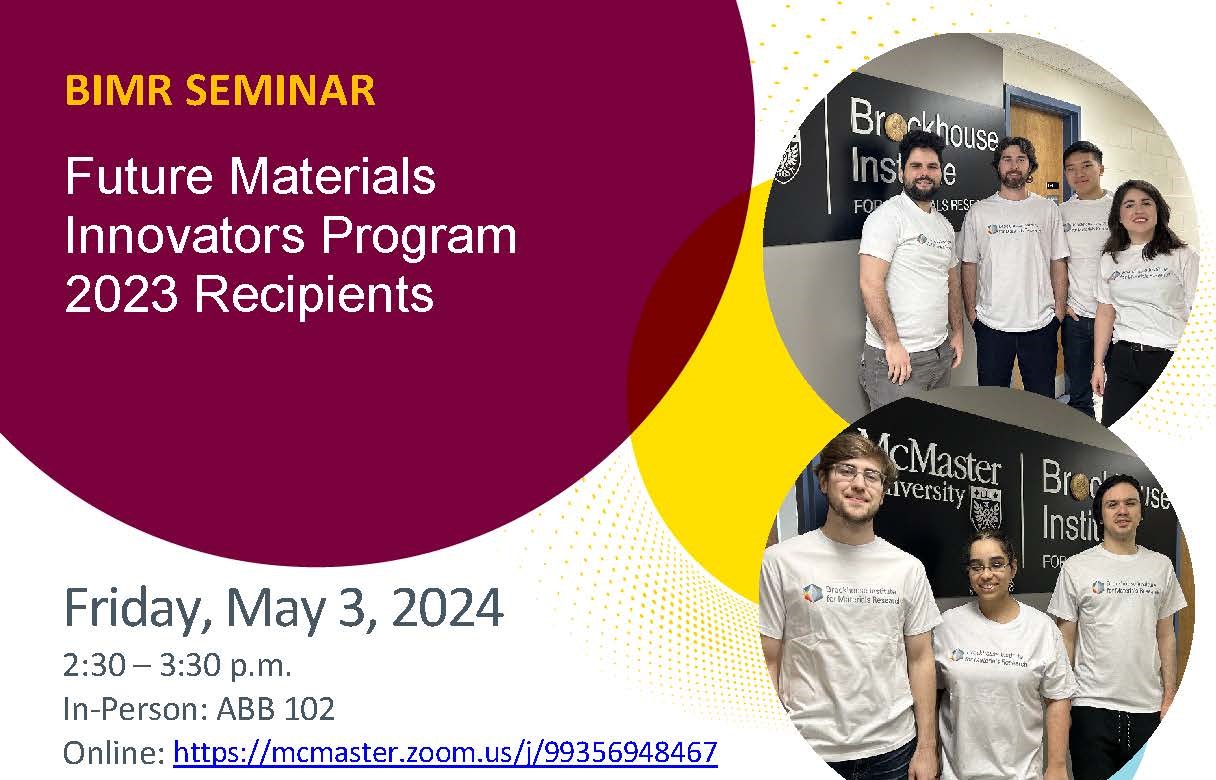Future Materials Innovators Program 2023 Recipients – Final Update
May 3, 2024
2:30PM to 3:30PM

Date/Time
Date(s) - 03/05/2024
2:30 pm - 3:30 pm
Categories
- Development of a mixer for homogenous, reproducible, and gentle mixing of cells into viscous bioinks based on silk fibroin methacrylate (Silk-MA), by Ryan Singer, David González Martínez, Mabel Barreiro Carpio, Steven Wang (Moran Mirabal and Hirota groups)
Extrusion-based 3D bioprinting is becoming an increasingly important tool in biomedical research. The technique has been widely adopted for tissue engineering applications due to its versatility and ability to fabricate custom cell-laden 3D biostructures. However, bioink materials that are printable via extrusion require high viscosity, which impedes the mixing of cells and often results in non-uniform distribution or low cell viability.
In this work, a liquid-like-solid bioink for extrusion bioprinting based on silk fibroin methacrylate (Silk-MA) was developed and characterized. Three static mixer geometries were designed, 3D printed, and evaluated for their ability to mix aqueous fluorescent particles with a composite fluid composed of polyethylene glycol diacrylate and gelatin methacrylate (PEGDA-Gel-MA). Output mixtures were photo-crosslinked and sliced axially to obtain cross-sectional fluorescence images using a confocal microscope. Mixing was quantified via the coefficient of variation of pixel intensity throughout cross-sectional slices. PEGDA-Gel-MA was used to mimic Silk-MA for this stage of evaluation because it is more accessible and has similar rheological properties to those of Silk-MA. Computational fluid dynamics were used to inform potential shear stresses and static pressures cells may experience in each mixer.
The two static mixer geometries with the most homogenous mixing were applied to mix two cell types into Silk-MA: fibroblast cells (3T3 cell line) and epithelial cells (A431 cell line). Output mixtures were used to print 2D and 3D structures, from which the printability and consistency of extruded material were evaluated. Cell viability was quantified post-mixing and post-printing using LIVE/DEAD™ fluorescence imaging. This work will add Silk-MA to the scarce library of extrusion-printable biomaterials and introduce a generalizable method to mix cells with liquid-like-solid bioinks to facilitate the applicability of these formulations.
- Modelling Drug Clearance Using the IFlowPlate™-T, by Michael Celejewski, Mandeep Marway and Anthony D’Angelo (Zhang and Wylie groups)
Current in vitro models do not incorporate continuous drug clearance, and so decreases in drug concentration to subtherapeutic levels over time are not mimicked in cell-based assays. Organ-on-a-chip devices are used to mimic the functionality of human organs in 3D models, and to serve as more accurate systems than 2D cell cultures or animal models. Such systems would be instrumental towards the study of cancer. Previous work (Marway et al., manuscript in progress) has highlighted how immune cells contribute to an immunosuppressive tumor environment in 3D cell cultures. Key players include monocytes (cells that travel through the blood and respond to their external environment and can become pro-cancer macrophages in the tumor environment) and endothelial cells (cells that regulate transport between the blood stream and surrounding tissues). Having demonstrated the capacity of the high throughput IFlowPlate™-T for establishing a 3D cell culture system with continuous clearance, the device was used to model local administration of a well-studied protein therapeutic, interferon gamma (IFN?, 50 ng/mL). A 3D glioblastoma (GBM) cancer culture was maintained, containing spheroids of GBM cells, a layer of human umbilical vein endothelial cells (HUVECs), and THP-1 monocytes that migrate across the layer of HUVECs. To demonstrate the applicability of the IFlowPlate™-T for the assessment of local drug delivery vehicles, a condition with agarose (1%) was incorporated as a passive drug release system for IFN?. Cytokine analysis was performed on culture media (with and without clearance) at the 72 h mark to track clearance of IFN?. By including conditions in the presence and absence of an antibody that recognizes the GBM cells, anti-CD133 (100 µg/mL), we highlight the capacity of the IFlowPlate™-T for the study of promising local anti-cancer combination therapies.
Followed by a BIMR Reception!
To celebrate the end of another successful Seminar Season with this last seminar, we are pleased to invite all our members to a Reception after the Future Materials Innovators Seminar. Join us to share a few appetizers and mingle with your colleagues.
Reception to follow the Seminar at our usual location just outside room ABB 102.
In-Person: ABB 102
Online: https://mcmaster.zoom.us/j/99356948467
Meeting ID: 993 5694 8467
Passcode: 451021

